|
|
 |
Canadian Historic Sites: Occasional Papers in Archaeology and History No. 26
St. Andrew's Presbyterian Church, Lake Bennett, British Columbia
by Margaret Carter
A Hectic Limbo
In late April, Grant (Fig. 21) left to go to Lake
Laberge where the ice would clear earlier than it would at Bennett.
There, he would build his own boat to travel to his new mission at
Dawson. Meanwhile, Dickey (Fig. 22) was to stay in Bennett to await
Grant's successor, then follow the miners into the creek area around
Eldorado. As he waited, he lived in Grant's "manse" and applied for the
lot in Bennett where the church tent was pitched.
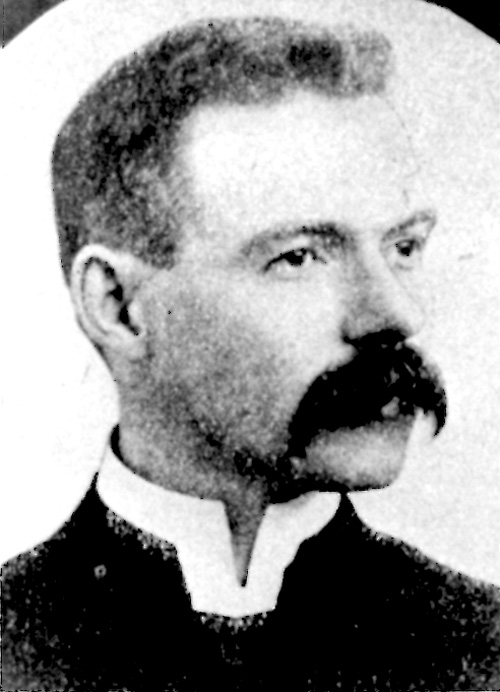
21 Rev. R.S. Grant, first minister at St. Andrew's Church, Lake
Bennett.
(United Church Archives, Toronto.)
|

22 Rev. R.M. Dickey, second-minister at St. Andrew's Church,
Lake Bennett.
(United Church Archives, Toronto.)
|
One afternoon in mid-May, Dickey returned to the
church tent and
found someone — 'apparently drunk'
— in possession, and by carrying out the delusion for a few
minutes I had an interesting exhibition of the good nature, sympathy
and tact which characterizes Dickey in all his work. You may imagine his
surprise when the supposed drunk suddenly sat up and announced himself
as his successor at Skagway sent by the Committee.1
The joker was the Reverend J.A. Sinclair (Fig.
23), newly arrived in the Yukon from his parish at Spencerville, British
Columbia. As he had been in transit since Dickey's move in April, he had
not heard of his relocation.
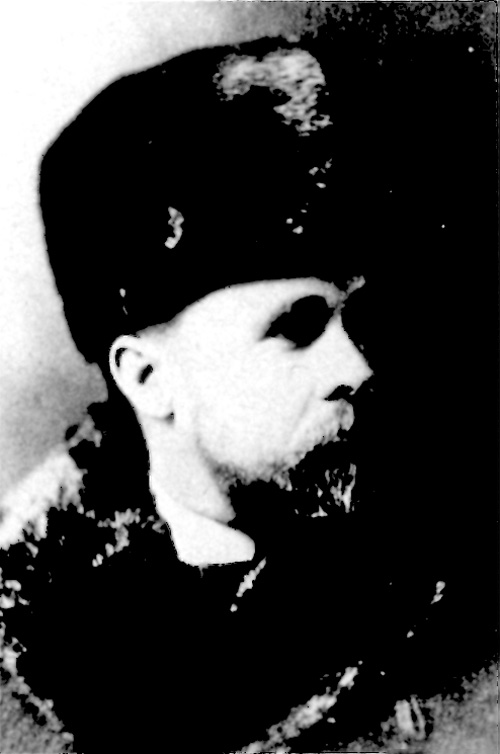
23 Rev. J.A. Sinclair, third minister at St. Andrew's Church,
Lake Bennett.
(Sinclair Papers.)
|
With Sinclair's arrival, Dickey was free to continue
on to Dawson. He nevertheless stayed until July 1898 to initiate his
successor in the ways of the Yukon mission field. One of his more pleasant
duties was to introduce Sinclair to the Klondikers at the head of
the lake: some of this occurred at a series of evening
socials.2 At a social in honour of Dickey's departure,
Sinclair learned a lesson about the men he was to work with when an
ex-wild west showman, Captain Jack Crawford, recited a poem he had
composed on the state of Klondike madness. Ridiculing the dangers of the
river journey ahead, the worries about families left behind, the hazards
of the trail, the horrors of the food and the corruption around him,
Crawford urged the Klondikers to forget their problems with a spirited
"say 'never die'" (see Appendix A). His verse emphasized uncertainty,
and it touched a responsive chord in most of the men at the gathering,
for Crawford had a knack of reflecting the sentiments of those around
him.3
This uncertainty was also evident in Sinclair's
activity after Dickey left. As was stated earlier, Sinclair was
appointed Dickey's successor at Skagway; however, when he arrived in
the north he found that Dickey had moved inland to Bennett because
Skagway had been declared American. When he arrived in Skagway, Sinclair
had also found the manse and church Dickey built there occupied by an
American Episcopal minister, a Dr. Campbell. Dickey had left the
buildings in Campbell's keeping on the understanding that he would
become the "resident Minister of the Union Church of Skagway" and
maintain the interdenominational character in which Dickey had founded and
operated the mission. Sinclair, however, found that Campbell reserved
the right to restrict the use of the church to visiting ministers who
wished to offer services in their own denominations. Campbell had also
scheduled Episcopalian services at eleven in the morning, the best
time, leaving to the other denominations the division of the eight
o'clock hour.4 Sinclair was not prepared to see the
Presbyterians so easily pushed out of the church they had constructed
in Skagway. He sent for an American replacement, and resolved that until
such a man arrived he would himself service Skagway, Bennett, and the
43-mile area in between.
This area comprised Sinclair's ministry from May of
1898 to May of 1899. During that time, portions of it were continuously
occupied by construction gangs building the railroad from Skagway to
Bennett (Fig. 24), and Sinclair visited the camps frequently as he made
his rounds "by canoe, on horseback or on foot"5 (Fig. 25). As
the rail-line progressed, he rode from Skagway to the end of the line
and continued his cold march from there. He soon was known and trusted
by both railway men and management, and this allowed him to successfully
negotiate a dispute between them during the spring of 1899.
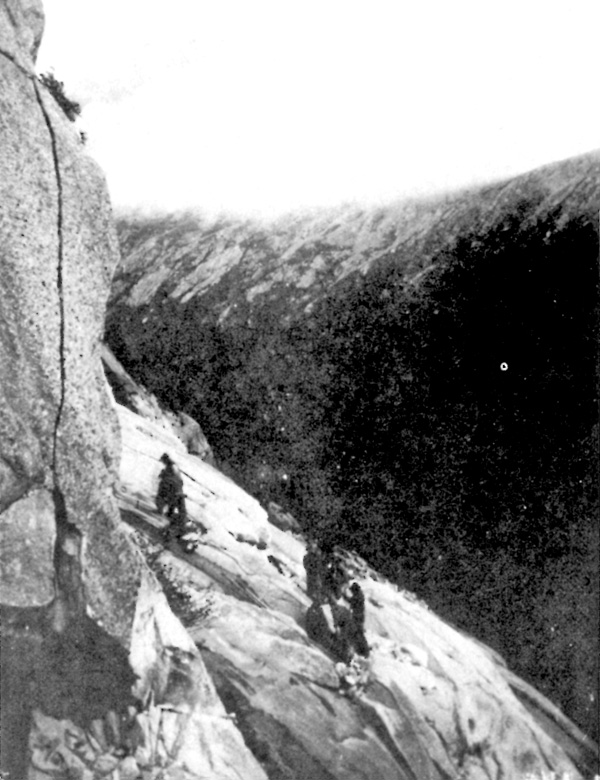
24 Railway contruction. Men at work secured by ropes.
(Sinclair
Papers.)
|
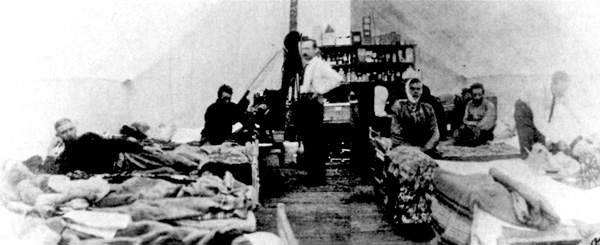
25 Interior, railway camp hospital, 1898. Sinclair visited the
location regularly.
(Sinclair Papers.)
|
No matter how much he travelled, Sinclair felt the
services of one man were inadequate. By April of 1899 when he wrote to
Rev. Norman B. Harrison who had been named his successor in Skagway, he
was beginning to show signs of strain. "I shall probably spend one week
at Bennett and then two here [Skagway]. This is the best I can do until
you or someone else arrives. But that is far from doing justice to this
important work. So I hope you will hurry."6 All the time
Sinclair was occupied with Skagway he was attempting to keep the church
going in Bennett. He managed this with the assistance of a layman, who
held services there when he was not available. Nevertheless the task was
a frustrating one.
Sinclair was always aware that if conditions remained
favourable he would move to a parish in Bennett after he left Skagway.
As a result, he watched developments in Bennett closely. During August
1898, he realized that the lot Grant had chosen for his "manse" was
outside the area that was developing as the centre of town. In 1898 this
began to shift away from Lindeman-Bennett rapids area on the southwest
corner of the lake and towards the southeast corner where the wagon road
on the White Pass trail was nearing completion (Figs. 26 and 27).7 It
was the latter area where Sinclair selected a second property as the
future location for his church. He petitioned the British Columbia
government for the property, knowing that if a town stabilized in
Bennett this land would be needed to build a church. When he returned to
Bennett for his next visit in October, "I found the site built upon by
Maitland Kersey of Dunraven Yacht race fame."8 Rather than
cause unnecesary tension, he elected to select another on the government
reserve9 and,
in order to prevent this being also 'jumped', I went for our
large tent which was in the shack [Grant's manse], to hold
down the lot, but I found the tent so cut up and so much of it gone
as to make it utterly useless. The theives were found, tried, and sentenced,
but this did not help us out of the difficulty.10

26 Bennett in 1898.
(Provincial Archives of British Columbia.)
|
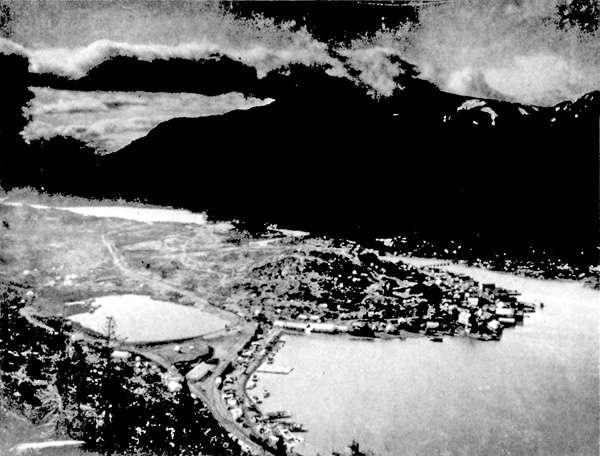
27 Lake Bennett, October 1899.
(Sinclair Papers.)
|
"The difficulty" can be neatly defined as no tent in which to
hold services in Benntt during the cold winter of 1898-99. Such
accommodation had been unncessary during Sinclair's summer visits,
but the coming of winter presented a serious problem. This was
temporarily solved when the Portland and Northern hotels11
offered their "dining rooms" — although each probably had only
one room for bar, food and sleeping — as accommodation for
services during Sinclair's visit (fig. 28). While the hotels
satisfied the major requirement of "shelter," they were less than
ideal as the location for a church. The constant arrival of dog
teams yielded hungry travellers and prevented tables from being
cleared for an early service; people were turned away from the
buildings for lack of room. By the end of the winter, a
combination of the inconvenience of the hotels, the receptiveness
of the people he had been preaching to, and the solid prospects
of Bennett as a major transshipment centre for the Klondike had
convinced Sinclair that he should build a church in the town.12
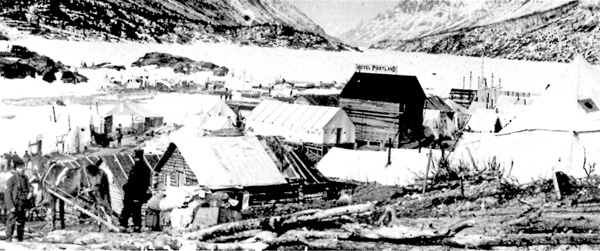
28 Services were held in the Hotel Portland during the winter
of 1898 and 1899.
(Yukon Archives, Vogee Collection.)
|
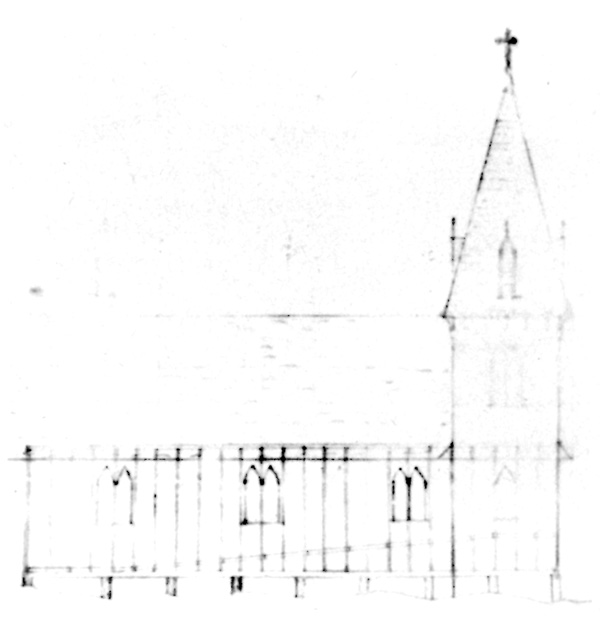
29 Sketch of exterior of the church prepared by Sinclair in late
May or early June 1899.
(Sinclair Papers.)
|
|

